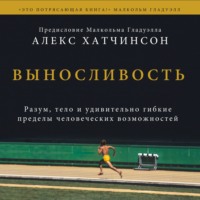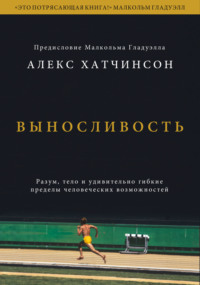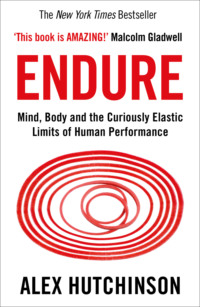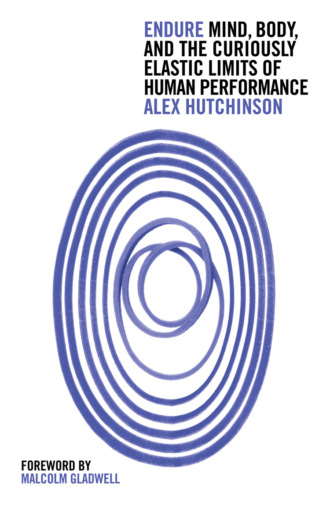
Полная версия
Endure: Mind, Body and the Curiously Elastic Limits of Human Performance

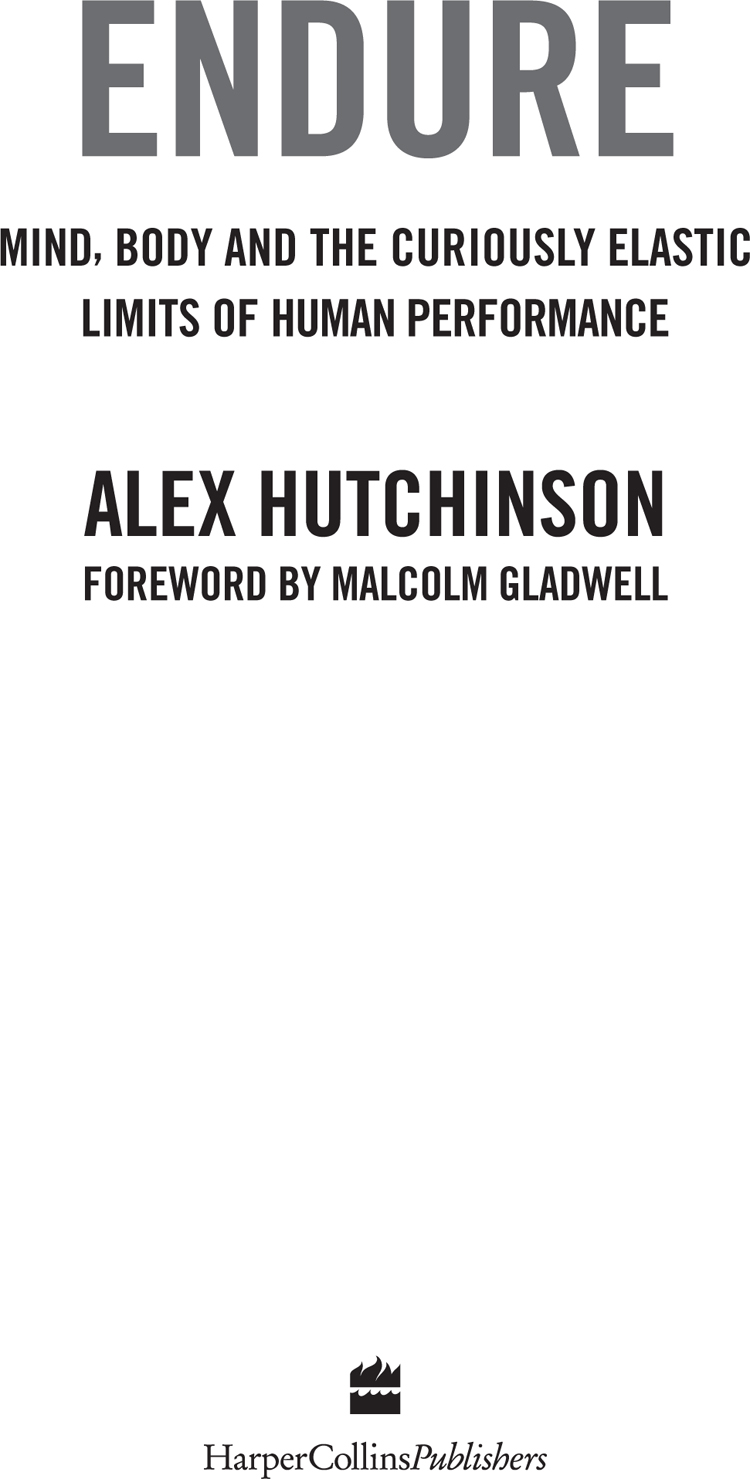
Copyright
HarperCollinsPublishers
1 London Bridge Street
London SE1 9GF
www.harpercollins.co.uk
This edition published by HarpercollinsPublishers 2018
FIRST EDITION
Text © Alex Hutchinson 2018
Cover layout design ©HarperCollinsPublishers Ltd 2018
A catalogue record of this book is available from the British Library
Alex Hutchinson asserts the moral right to be identified as the author of this work
All rights reserved under International and Pan-American Copyright Conventions. By payment of the required fees, you have been granted the nonexclusive, non-transferable right to access and read the text of this e-book on screen. No part of this text may be reproduced, transmitted, downloaded, decompiled, reverse engineered, or stored in or introduced into any information storage retrieval system, in any form or by any means, whether electronic or mechanical, now known or hereinafter invented, without the express written permission of HarperCollins e-books.
Find out about HarperCollins and the environment at www.harpercollins.co.uk/green
Source ISBN 978-0-00-828509-8
Ebook Edition © February 2018 ISBN: 9780008277079
Version 2018-02-08
Dedication
For my parents, Moira and Roger, whose curiosity, rigor,
respect for differing perspectives, and talent for clarity remain
the model I strive for in everything I write.
Contents
Cover
Title Page
Copyright
Dedication
Foreword by Malcolm Gladwell
Two Hours: MAY 6, 2017
PART I: MIND AND MUSCLE
CHAPTER 1 The Unforgiving Minute
CHAPTER 2 The Human Machine
CHAPTER 3 The Central Governor
CHAPTER 4 The Conscious Quitter
Two Hours: NOVEMBER 30, 2016
PART II: LIMITS
CHAPTER 5 Pain
CHAPTER 6 Muscle
CHAPTER 7 Oxygen
CHAPTER 8 Heat
CHAPTER 9 Thirst
CHAPTER 10 Fuel
Two Hours: MARCH 6, 2017
PART III: LIMIT BREAKERS
CHAPTER 11 Training the Brain
CHAPTER 12 Zapping the Brain
CHAPTER 13 Belief
Two Hours: MAY 6, 2017
Acknowledgments
Notes
Index of searchable terms
About the Publisher
Foreword
By Malcolm Gladwell
All distance runners have races that, in retrospect, make no sense. I have two. The first came when I was thirteen, in my first year of high school. With no more than a month of training under my belt, I ran a cross-country race in Cambridge, Ontario, against boys two years older than me. One of them was among the best distance runners for his age in the province. I can summon the memories of that race even today, forty years later. I simply attached myself to the leaders at the beginning and never let go, and ran myself to complete exhaustion, finishing a close and utterly inexplicable second. I say inexplicable because although I would go on to have a creditable career as a middle-distance runner on the track in high school, that race remains the only truly superb distance race I’ve ever run. I’ve underperformed at anything over 1,500 meters for the rest of my running life.
That is: with one exception. Two years ago, at the age of fifty-one, I ran a magical 5K in a small-town race in New Jersey, finishing a full minute faster than any 5K I’d entered since returning to serious running as a Master. On that summer day in New Jersey, I was suddenly my thirteen-year-old self from forty years ago in Cambridge. I dreamt big. I marveled at my running prowess. And then? Back to mediocrity again.
Like the obsessive person—and particularly obsessive runner—that I am, I have puzzled endlessly over two those anomalous races. I have running logs from my teenage years, and I’ve gone back over them, looking for clues. Was there some indication in my earliest training of that kind of performance? Did I do something special? For my latter 5K, of course, I have infinitely more. Months of data from Garmin on every workout leading up to the event, and then still more from the day of the race itself: pace, cadence, splits. On more than one occasion, leading up to a race, I’ve attempted to replicate the exact preparation I had for my New Jersey PR. I want lightning to strike twice. It hasn’t, and I’m beginning to suspect the reason it hasn’t is that I don’t properly understand what it means to perform a feat of endurance. I think you can see where I’m going with this: I am the perfect audience for Alex Hutchinson’s Endure.
A few words about Alex Hutchinson. We are both Canadians and both runners, although he is both a better Canadian (he still lives there; I don’t) and a much better runner than I ever was. He invited me once to a tempo run he does with his friends on Saturday mornings in a cemetery in North Toronto. As I recall, I finished last—or maybe second last, since one of his running crew very sweetly condescended to run at my pace. Alex disappeared from sight after the first bend. As you will discover, as you continue in these pages, Alex writes about the mysteries of endurance as a student of the science, a sports fan, and a keen observer of human performance—but also as a participant. He has his own anomalous races to explain.
It must be stressed, though, that this is not a running book. There are plenty of running books out there, and as a runner I have read many of them. But they are insider’s accounts written for other insiders: whether or not a runner should fore-foot or heel-strike, or aim for a cadence of 180 strides per minute, is a question only of significance to runners whose self-involvement extends all the way to the soles of their feet. But one of the (many) pleasures of Endure is how convincingly Hutchinson broadens the stakes. In one of my favorite passages, from the chapter on pain, Hutchinson writes of the attempt by Jens Voigt to break cycling’s “one-hour” record. Voigt was famously indifferent to pain. But when he climbed off his bike, after breaking the record, Hutchinson tells us he was in agony: “the pain he’d been pushing to the margins of his consciousness came crashing down.” That is a cycling story. But in Hutchinson’s hands it also becomes a way of asking a much deeper and more consequential question about how our physiology interacts with our psychology. In a wide variety of human activity, achievement is not possible without discomfort. So what is our relationship to that pain? How do the signals of protest from our brain interact with the physical will to keep moving? You don’t have to be a maniacal cyclist to appreciate that discussion. If anything, that discussion is likely to dissuade you from ever becoming a maniacal cyclist. “Everything was aching,” Voigt said. “My neck ached from holding my head low in that aerodynamic position. My elbows hurt from holding my upper body in that position. My lungs hurt after burning and screaming for oxygen for so long. My heart hurt from the constant pounding. My back was on fire, and then there was my butt! I was really and truly in a world of pain.” Oh man. It was painful just to read that passage.
Does Endure solve the puzzle of the anomalous race? In one sense, yes. My problem, I now realize, is that I tried to make sense of those performances using an absurdly simple model of endurance. The time I ran was my output. And so I worked backward and tried to identify the corresponding inputs that must have made it possible. Did I take one day of rest beforehand, or two? How quick was that hill workout the week before? Is there something to be learned from the last set of intervals I did? The data that we gather from our GPS sports watches makes this kind of thinking even more seductive: it encourages us to paint a simple picture of how and why our body moves through the world. After you’ve read Endure, I promise you, you’ll never settle for the simple picture again. There are many things Garmin cannot tell you. And luckily, for those many things, we have Alex Hutchinson.
Two Hours
May 6, 2017
The broadcast booth at the Autodromo Nazionale Monza, a historic Formula One racetrack nestled in the woodlands of a former royal park northeast of Milan, Italy, is a small concrete island suspended in the air over the roadway. From this rarefied vantage point, I’m trying to offer thoughtful guest commentary to a live-streaming audience of an estimated 13 million people around the world, many of whom have rousted themselves out of bed in the middle of the night to watch. But I’m getting antsy.
The race beneath me is hurtling toward a conclusion that almost no one, through months of speculation and spirited debate, had considered possible. Eliud Kipchoge, the reigning Olympic marathon champion, has been circling the racetrack for an hour and forty minutes behind an exquisitely choreographed formation of runners blocking the wind for him—and, remarkably, he’s still on pace to run under two hours for 26.2 miles. Given that the world marathon record is 2:02:57, and given that records are usually shaved down in hard-fought seconds, Kipchoge’s performance is already straining the limits of my ability to convey surprise and awe. Giant screens in front of me are flashing detailed statistics about Kipchoge’s run, but my mind is drifting away from punditry. I want to slip out of the booth and get back down to the side of the track—to feel the crackling tension in the assembled crowd, to hear the rasp of Kipchoge’s breath as he runs past, and to look into his eyes as he pushes deeper into the unknown.
In 1991, Michael Joyner, an ex-collegiate runner from the University of Arizona who was completing a medical residency at the Mayo Clinic in Minnesota, proposed a provocative thought experiment. The limits of endurance running, according to physiologists, could be quantified with three parameters: aerobic capacity, also known as VO2max, which is analogous to the size of a car’s engine; running economy, which is an efficiency measure like gas mileage; and lactate threshold, which dictates how much of your engine’s power you can sustain for long periods of time. Researchers had measured these quantities in many elite runners, who tended to have very good values in all three parameters and exceptional values in one or two. What would happen, Joyner wondered, if a single runner happened to have exceptional—but humanly possible—values in all three parameters? His calculations suggested that this runner would be able to complete a marathon in 1:57:58.
The reactions to his paper, which was published in the Journal of Applied Physiology, were mostly quizzical. “A lot of people scratched their heads,” Joyner recalls. The world record at the time, after all, was 2:06:50, which the Ethiopian runner Belayneh Densimo had run in 1988. A sub-two-hour marathon was not on anyone’s radar—in fact, when Joyner first presented his ideas in the mid-1980s, the idea was considered so preposterous that his paper was initially rejected for publication. But the seemingly outrageous time was not a prediction, Joyner emphasized—it was a challenge to his fellow scientists. In some ways, his calculation was the apotheosis of a century’s worth of attempts to quantify the outer limits of human endurance. This is how fast a human can run, the equations said. So what explained the chasm between theory and reality? Was it simply a question of waiting for the perfect runner to be born or the perfect race to be run—or was something missing from our understanding of endurance?
Time passed. In 1999, the Moroccan runner Khalid Khannouchi became the first person to dip below 2:06. Four years later, Paul Tergat of Kenya breached 2:05; five years after that Haile Gebrselassie of Ethiopia broke 2:04. By 2011, when Joyner and two colleagues published an updated paper in the Journal of Applied Physiology titled “The Two-Hour Marathon: Who and When?” the idea no longer seemed ridiculous. In fact, the journal published an unprecedented thirty-eight responses from other researchers, speculating on the various factors that might bring the barrier closer. In late 2014, shortly after Dennis Kimetto of Kenya posted the first sub-2:03, a consortium led by a British sports scientist named Yannis Pitsiladis announced plans to break the two-hour barrier within five years.
Still, two minutes and fifty-seven seconds remained a substantial gap. Also in 2014, Runner’s World magazine asked me to undertake a comprehensive analysis of the physiological, psychological, and environmental factors that would need to come together for someone to run a two-hour marathon. After reviewing mountains of data and consulting experts around the world, including Joyner, I presented ten pages of charts, graphs, maps, and arguments, concluding with my own prediction: the barrier would fall, I wrote, in 2075.
That prediction leapt immediately to mind in October 2016, when I got an unexpected call from David Willey, then the editor in chief of Runner’s World. Nike, the biggest sports brand in the world, was preparing to unveil a “top-secret” project that aimed to deliver a sub-two marathon in just six months. We were being offered the opportunity to go behind the scenes to cover the initiative, which they’d dubbed Breaking2. I didn’t know whether to laugh or roll my eyes, but I couldn’t say no. I agreed to fly to Nike’s headquarters, in the Portland, Oregon, suburb of Beaverton, a few weeks later to hear their pitch. If someone had to debunk an overhyped marketing exercise, I figured the research for my earlier Runner’s World piece had left me as well equipped as anyone.
As my guest spot on the television broadcast wraps up, Kipchoge hits twenty-three miles. It’s May 6, 2017, exactly sixty-three years to the day after Roger Bannister ran the first sub-four-minute mile. I’m nearly frantic to get track-side now—but I’m not sure how to get down from my lofty perch in the broadcast booth. Peering over the edge, I briefly contemplate swinging myself over the railing and risking the drop. But a stern glance from a nearby security guard dissuades me. Instead, I head back over the causeway that connects the broadcast booth to the main building’s multistory maze of dead-end hallways and unlabeled doors. I don’t have time to wait for a guide. I break into a run.
CHAPTER 1
The Unforgiving Minute
If you can fill the unforgiving minute
With sixty seconds’ worth of distance run,
Yours is the Earth and everything that’s in it … .
—RUDYARD KIPLING
On a frigid Saturday night in the university town of Sherbrooke, Quebec, in February 1996, I was pondering—yet again—one of the great enigmas of endurance: John Landy. The stocky Australian is one of the most famous bridesmaids in sport, the second man in history to run a sub-four-minute mile. In the spring of 1954, after years of concerted effort, centuries of timed races, millennia of evolution, Roger Bannister beat him to it by just forty-six days. The enduring image of Landy, immortalized in countless posters and a larger-than-life bronze statue in Vancouver, British Columbia, comes from later that summer, at the Empire Games, when the world’s only four-minute milers clashed head-to-head for the first and only time. Having led the entire race, Landy glanced over his left shoulder as he entered the final straightaway—just as Bannister edged past on his right. That split-second tableau of defeat confirmed him as, in the words of a British newspaper headline, the quintessential “nearly man.”
But Landy’s enigma isn’t that he wasn’t quite good enough. It’s that he clearly was. In pursuit of the record, he had run 4:02 on six different occasions, and eventually declared, “Frankly, I think the four-minute mile is beyond my capabilities. Two seconds may not sound much, but to me it’s like trying to break through a brick wall.” Then, less than two months after Bannister blazed the trail, Landy ran 3:57.9 (his official mark in the record books is 3:58.0, since times were rounded to the nearest fifth of a second in that era), cleaving almost four seconds off his previous best and finishing 15 yards ahead of four-minute pace—a puzzlingly rapid, and bittersweet, transformation.
Like many milers before me and since, I was a Bannister disciple, with a creased and nearly memorized copy of his autobiography in permanent residence on my bedside table; but in that winter of 1996 I was seeing more and more Landy when I looked in the mirror. Since the age of fifteen, I’d been pursuing my own, lesser four-minute barrier—for 1,500 meters, a race that’s about 17 seconds shorter than a mile. I ran 4:02 in high school, and then, like Landy, hit a wall, running similar times again and again over the next four years. Now, as a twenty-year-old junior at McGill University, I was starting to face the possibility that I’d squeezed out every second my body had to offer. During the long bus ride from Montreal to Sherbrooke, where my teammates and I were headed for a meaningless early-season race on one of the slowest tracks in Canada, I remember staring out the window into the swirling snow and wondering if my long-sought moment of Landyesque transformation would ever arrive.
The story we’d heard, possibly apocryphal, was that the job of designing the Sherbrooke indoor track had been assigned to the university’s engineering department as a student project. Tasked with calculating the optimal angles for a 200-meter track, they’d plugged in numbers corresponding to the centripetal acceleration experienced by world-class 200-meter sprinters—forgetting the key fact that some people might want to run more than one lap at a time. The result was more like a cycling velodrome than a running track, with banks so steep that even most sprinters couldn’t run in the outside lanes without tumbling inward. For middle-distance runners like me, even the inside lane was ankle-breakingly awkward; races longer than a mile had to be held on the warm-up loop around the inside of the track.
To break four minutes, I would need to execute a perfectly calibrated run, pacing each lap just two-tenths of a second faster than my best time of 4:01.7. Sherbrooke, with its amusement-park track and an absence of good competition, was not the place for this supreme effort, I decided. Instead, I would run as easily as possible and save my energy for the following week. Then, in the race before mine, I watched my teammate Tambra Dunn sprint fearlessly to an enormous early lead in the women’s 1,500, click off lap after metronomic lap all alone, and finish with a scorching personal best time that qualified her for the national collegiate championships. Suddenly my obsessive calculating and endless strategizing seemed ridiculous and overwrought. I was here to run a race; why not just run as hard as I could?
Reaching the “limits of endurance” is a concept that seems yawningly obvious, until you actually try to explain it. Had you asked me in 1996 what was holding me back from sub-four, I would have mumbled something about maximal heart rate, lung capacity, slow-twitch muscle fibers, lactic acid accumulation, and various other buzzwords I’d picked up from the running magazines I devoured. On closer examination, though, none of those explanations hold up. You can hit the wall with a heart rate well below max, modest lactate levels, and muscles that still twitch on demand. To their frustration, physiologists have found that the will to endure can’t be reliably tied to any single physiological variable.
Part of the challenge is that endurance is a conceptual Swiss Army knife. It’s what you need to finish a marathon; it’s also what enables you to keep your sanity during a cross-country flight crammed into the economy cabin with a flock of angry toddlers. The use of the word endurance in the latter case may seem metaphorical, but the distinction between physical and psychological endurance is actually less clear-cut than it appears. Think of Ernest Shackleton’s ill-fated Antarctic expedition, and the crew’s two-year struggle for survival after their ship, the Endurance, was crushed in the ice in 1915. Was it the toddlers-on-a-plane type of endurance that enabled them to persevere, or straightforward physical fortitude? Can you have one without the other?
A suitably versatile definition that I like, borrowing from researcher Samuele Marcora, is that endurance is “the struggle to continue against a mounting desire to stop.” That’s actually Marcora’s description of “effort” rather than endurance (a distinction we’ll explore further in Chapter 4), but it captures both the physical and mental aspects of endurance. What’s crucial is the need to override what your instincts are telling you to do (slow down, back off, give up), and the sense of elapsed time. Taking a punch without flinching requires self-control, but endurance implies something more sustained: holding your finger in the flame long enough to feel the heat; filling the unforgiving minute with sixty seconds’ worth of distance run.
The time that elapses can be seconds, or it can be years. During the 2015 National Basketball Association playoffs, LeBron James’s biggest foe was—with all due respect to Golden State defender Andre Iguodala—fatigue. He’d played 17,860 minutes in the preceding five seasons, more than 2,000 minutes ahead of anyone else in the league. In the semis, he surprisingly asked to be pulled from a game during a tense overtime period, changed his mind, drained a three-pointer followed by a running jumper with 12.8 seconds left to seal the victory, then collapsed to the floor in a widely meme-ified swoon after the buzzer. By Game 4 of the finals, he could barely move: “I gassed out,” he admitted after being held scoreless in the final quarter. It’s not that he was acutely out of breath; it was the steady drip of fatigue accumulating over days, weeks, and months that just as surely pushed James to the limits of his endurance.
At the opposite end of the spectrum, even the greatest sprinters in the world fight against what John Smith, the coach of former 100-meter world-record holder Maurice Greene, euphemistically calls the “Negative Acceleration Phase.” The race may be over in ten seconds, but most sprinters hit their top speed after 50 to 60 meters, sustain it briefly, then start to fade. Usain Bolt’s ability to stride magisterially away from his competitors at the end of a race? A testament to his endurance: he’s slowing down a little less (or a little later) than everyone else. In Bolt’s 9.58-second world-record race at the 2009 World Championships in Berlin, his last 20 meters was five hundredths of a second slower than the previous 20 meters, but he still extended his lead over the rest of the field.
At the same world championships, Bolt went on to set the 200-meter world record with a time of 19.19 seconds. A crucial detail: he ran the first half of the race in 9.92 seconds—an amazing time, considering the 200 starts on a curve, but still slower than his 100-meter record. It’s barely perceptible, but he was pacing himself, deliberately spreading his energy out to maximize his performance over the whole distance. This is why the psychology and physiology of endurance are inextricably linked: any task lasting longer than a dozen or so seconds requires decisions, whether conscious or unconscious, on how hard to push and when. Even in repeated all-out weightlifting efforts—brief five-second pulls that you’d think would be a pure measure of muscular force—studies have found that we can’t avoid pacing ourselves: your “maximum” force depends on how many reps you think you have left.


